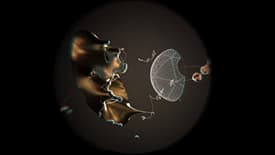‘SEE-ING’ symposium and exhibition to explore transformed notions of the visible

The School of Architecture will present a symposium and exhibition, “SEE-ING: The Environmental Consciousness Project,” from 1 to 6 p.m., Monday, Oct. 15. This multidimensional program, curated by Assistant Professor of Architecture Catty Dan Zhang, includes distinguished guest speakers, a dance performance and an immersive installation/exhibition that features work by a dozen artists and designers from across the globe.
The rapid evolution of technology – imaging techniques, virtual and augmented reality, sophisticated display systems, cameras at everyone’s fingertips – is profoundly changing the experience of “vision,” “visual” or “the visible.” The SEE-ING project both questions and celebrates the presence of technological facts and the profound joy of experiencing their effects. Bringing together a diverse group of architects, artists, designers and theorists, the project explores the effects of this transformation on creative practices. “Seeing,” in this sense, is not limited to the typical concept of visualization, but instead refers to a range of multilayered interfaces between people and their environment.
The Oct. 15 symposium begins at 1 p.m. in Storrs Hall and features two distinguished lecturers. Sandra Rodriguez (speaking at 1:45 p.m.) is creative director of the Creative Reality Lab at EyeSteelFilm and a visiting scholar in the Comparative Media Studies Department at Massachusetts Institute of Technology (MIT); Mark B.N. Hansen (speaking at 4 p.m.) is the James B. Duke Professor of Literature at Duke University.
A multimedia dance performance, “Captured Creatures,” will take place at 3 p.m. in Rowe Recital Hall. Created by visual artist Chai Mi, “Captured Creatures” has been performed in France, Malaysia and China. The performance features Assistant Professor of Dance Kaustavi Sarkar and dance students Katie Harmon, Dorian Benjamin, Kathryn King and Rahquelah Conyers.
The exhibition, which will be on view in Storrs Gallery through Friday, Nov. 16, presents the work of 11 visiting artists within Zhang’s immersive installation, “VENTS,” which uses articulated forms of airflow to construct environmental experiences. The installation consists of a “ceiling” of 69 modules that produce a rain of air puffs that are based on an input that hybridizes real-time local wind speeds and the recorded data sets of Hurricane Florence during a seven-day period. These invisible “breezes,” felt on the skin, will become visible as rings of colored droplets of light.
Photo: Penelope Haralambidou, Between the Retina and the Dome (film still)